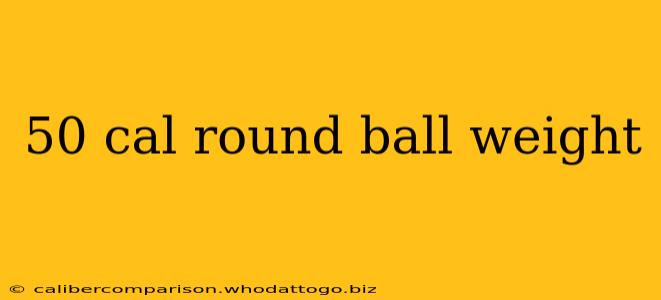The weight of a .50 caliber round ball is a crucial factor for both historical reenactors and modern enthusiasts of muzzleloading firearms. Understanding this weight, and the variations that exist, is key to accurate shooting and safe handling. This guide will delve into the specifics of .50 caliber round ball weight, exploring the factors influencing it and its implications for various applications.
Understanding Caliber and Ball Weight
Before we dive into the specifics of .50 caliber round balls, it's important to clarify the relationship between caliber and weight. Caliber refers to the diameter of the bore (the inside of the barrel) of a firearm. A ".50 caliber" firearm has a bore diameter of approximately 0.50 inches (12.7 mm). However, the weight of a round ball designed for this caliber can vary slightly due to several factors.
Factors Affecting Round Ball Weight:
-
Material: The most significant factor influencing weight is the material the ball is made from. Lead is the traditional and most common material, but other metals like tin or alloys may be used. Lead is denser than other common metals, resulting in a heavier ball for a given diameter.
-
Manufacturing Tolerances: Even with precise manufacturing processes, slight variations in the diameter and therefore the weight of individual round balls are inevitable. These tolerances are usually small but can accumulate, particularly when dealing with a large batch of balls.
-
Casting Process: The method used to cast the round balls can influence their weight. Hand-cast balls may show slightly more variation compared to those produced using more automated processes.
Typical Weight of a .50 Caliber Round Ball:
While there isn't one single definitive weight, a .50 caliber round ball made of lead typically weighs around 175-180 grains. This translates to approximately 11.3-11.6 grams. It's important to note that this is an average, and individual balls may be slightly heavier or lighter within this range.
Variations and Their Implications:
Minor variations in weight are generally acceptable and won't drastically affect accuracy in most shooting scenarios. However, significant variations could impact:
-
Accuracy: Inconsistency in ball weight can lead to inconsistent muzzle velocity and trajectory.
-
Barrel Wear: Overly heavy balls can increase barrel wear over time, whereas undersized balls may lead to inaccurate shots due to poor bore engagement.
-
Safety: Using a significantly oversized ball can lead to dangerous pressure buildup within the firearm, posing a safety risk.
Finding the Right .50 Caliber Round Ball:
If you're looking to purchase .50 caliber round balls, it's recommended to:
-
Check the manufacturer's specifications: Reputable manufacturers usually specify the weight range of their products.
-
Weigh a sample: Before using a large quantity, weigh a few balls to ensure they fall within an acceptable range.
-
Consult experienced shooters: Experienced muzzleloading enthusiasts can provide valuable insights into suitable ball weights for specific firearms.
This information should help you better understand the weight of .50 caliber round balls and the factors influencing it. Remember that safe handling and proper knowledge are paramount when working with any firearm. Always consult the manufacturer's instructions and seek guidance from experienced individuals when necessary.

